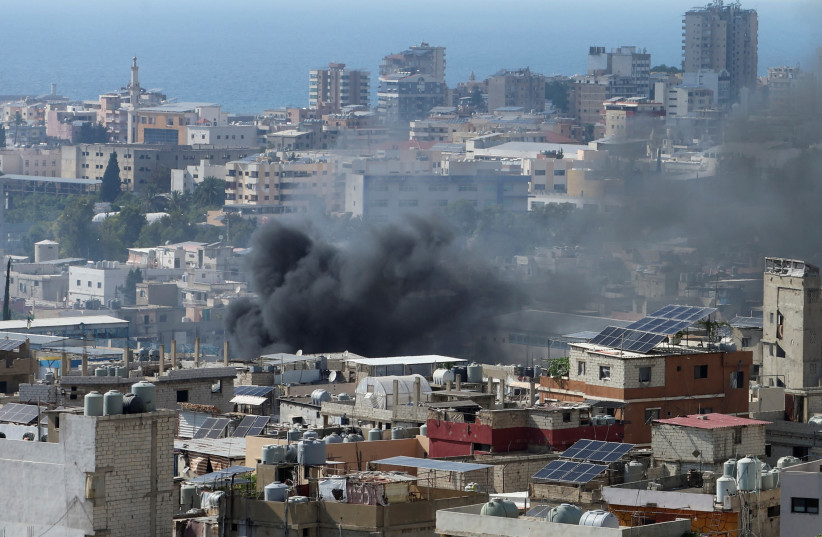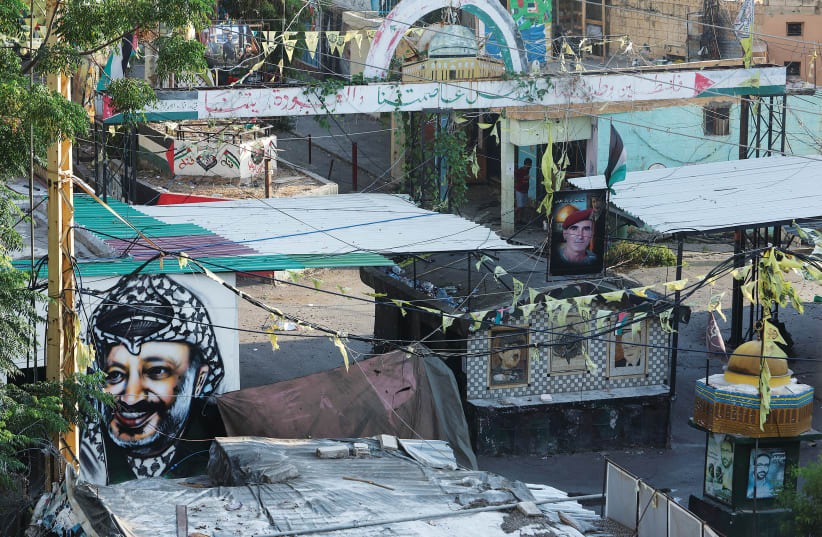A truce brokered earlier this week by the Lebanese General Security Service to end the ongoing fighting in the Palestinian Ain al-Hilweh refugee camp appears to have broken down, with renewed clashes taking place at various locations in the camp. A mass exodus of residents from the camp is underway, according to a number of regional media reports. Fighting in the camp began in late July but increased in intensity from September 7.
The truce was the result of talks between the interim director of General Security, Elias Baissari, and the Joint Palestinian Action Committee, representing all recognized Palestinian factions in Lebanon. It followed an earlier short-lived ceasefire, announced on September 9, which was the result of talks between representatives of Fatah and Hamas.
Following the breakdown of the second ceasefire, senior Hamas official Mohammed Mousa Abu Marzouk arrived in Beirut for renewed talks with senior Fatah officials, in an effort to revive the ceasefire. A joint statement was issued following Abu Marzouk’s meeting with Fatah officials, including veteran PLO diplomat Azzam al-Ahmad. The statement expressed the two movements’ “full commitment to consolidating the ceasefire.”
The flaw in both “ceasefires” so far brokered to end the violence in Ain al-Hilweh is that neither agreement was concluded between the actual parties to the current violence. Rather, in both cases, Fatah, which is one of the engaged parties, concluded a ceasefire with a third party against which it is not actually fighting in the refugee camp.
The agreement with General Security reflected the fact that the organs of the Lebanese state, in line with the 1969 Cairo Accord, leaves the policing of Lebanon’s 12 Palestinian refugee camps to the recognized, armed Palestinian organizations led by Fatah. So the “ceasefire” was by way of a commitment by the Palestinian organizations to restore order in the camp. This commitment, obviously, has not been successfully implemented.

The second ceasefire was brokered between Fatah and Hamas. The latter organization is not engaged in the fighting in the camp, but its attempt at a mediatory role is noteworthy. Hamas has increased its authority and strength in Lebanon over the last couple of years, as a result of its revived ties with the real power in the country – namely Hezbollah and behind it Iran and the Assad regime in Syria.
Lebanese journalist Souhayb Jawhar suggested that Hamas was seeking to leverage its growing strength and influence in Lebanon in order to build political influence. “In this way,” Jawhar told the New Arab website, “Hamas may benefit from this struggle while other sides get weakened.”
Still, while this may well be Hamas’s intention, as of now its efforts at mediation have similarly failed to produce results.
Who is Fatah actually fighting?
SO IF neither the formal Lebanese authorities nor Hamas with its links to the real power in Lebanon, namely Iran/Hezbollah, are party to the dispute in Ain al-Hilweh, who is Fatah actually fighting in the camp, in clashes that have left at least 18 people dead since their outbreak?
A number of reports have named an organization or framework calling itself the Muslim Youth as constituting Fatah’s antagonist in Ain al-Hilweh. Closer inspection reveals that this is not a coherent organization but, perhaps predictably, a collection of a number of Salafi and other Sunni jihadi outfits, combined with local gunmen intent on challenging Fatah’s control of the camp with local and parochial aims in mind. Among the former groups are Jund al-Sham, Asbat al-Ansar, and Ansar Allah.
Regarding these three groups, while the temptation might be to dismiss them as just another Sunni jihadi word salad of familiar terms, further consideration is warranted. The first two groups are indeed Salafi jihadi groups with deep roots in Ain al-Hilweh. Jund al-Sham may or may not have links to the group with the same name in Syria. Asbat al-Ansar first emerged in Ain al-Hilweh in the early 1990s and has long maintained its stronghold there.
Ansar Allah, by contrast, is a group founded by former Fatah members but which, as its name suggests, is close to Hezbollah. Jamal Suleiman, a former Fatah activist, founded the organization in the 1990s. All of these organizations have a long history of opposition to Fatah, with various episodes of violence between them and the larger movement in the past in Ain al-Hilweh.
It is also important not to exaggerate the ideological element at play here. These groups compete with Fatah for local control of resources and for power, as much as for any notional differences in preferred forms of governance.
The current fighting differs from previous episodes, since over the last decade Ain al-Hilweh has become swollen with the arrival of thousands of refugees from Syria, who have made their homes there without official registration. Ain al-Hilweh houses 55,000 registered Palestinian refugees. But the actual population is much larger.
Many of these Syrian Sunni refugees will have come with the loyalties forged in the course of the civil war in their country. As such, they are less likely to be constrained by traditional Palestinian affiliations.
THE EVENTS at Ain al-Hilweh showcase a number of trends.
Firstly, they lay bare the advancing decrepitude of Fatah. The official Palestinian leadership is currently unable to quickly crush the poorly organized challenge to its authority in the camp.
Its weakness here is made more apparent because, unlike in the West Bank, it is unable to call on the assistance of a stronger neighboring factor. That is because while in the West Bank, Israel cooperates with the Palestinian Authority; in Lebanon, the official authorities stay out of the camp, while the real power, Hezbollah/Iran, does not back Fatah.
Secondly, the events in the camp reflect the unfortunate inability of Sunni Arab politics, and arguably of Sunni Arab social organization more generally, to outgrow the level of development in which armed clans and gangs flourish and dominate the public space, with issues decided through bloody contests between them.
Thirdly, and perhaps most importantly, the growing influence and power of Hamas is reflected in its efforts to play a mediating role. The attempt at mediation may have failed, but the fact that Hamas was able to credibly attempt it indicates the extent to which this movement is currently on the ascent.
This ascent is connected entirely to the successful effort at rapprochement with Iran that has been underway since the rise of Yahya Sinwar and the growing centrality of Saleh al-Arouri. That is, the advance of Hamas is happening because it is part of a broader strategy by Iran to take control of the Palestinian arena and make it part of a united, cross-border, Islamist, Tehran-led campaign against Israel.
This, in turn, reflects maybe the most telling point of all: that the strongest and most potent element among the Palestinians currently owes its strength to the fact that it works for an alliance led by a non-Sunni, non-Arab power. Whoever “wins” in Ain al-Hilweh, this defining weakness of what was once the flagship cause of the Sunni Arabs will remain.
